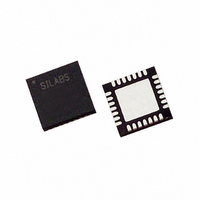C8051F353-GM Silicon Laboratories Inc, C8051F353-GM Datasheet - Page 141

C8051F353-GM
Manufacturer Part Number
C8051F353-GM
Description
IC 8051 MCU 8K FLASH 28MLP
Manufacturer
Silicon Laboratories Inc
Series
C8051F35xr
Specifications of C8051F353-GM
Program Memory Type
FLASH
Program Memory Size
8KB (8K x 8)
Package / Case
28-VQFN Exposed Pad, 28-HVQFN, 28-SQFN, 28-DHVQFN
Core Processor
8051
Core Size
8-Bit
Speed
50MHz
Connectivity
SMBus (2-Wire/I²C), SPI, UART/USART
Peripherals
POR, PWM, Temp Sensor, WDT
Number Of I /o
17
Ram Size
768 x 8
Voltage - Supply (vcc/vdd)
2.7 V ~ 3.6 V
Data Converters
A/D 8x16b; D/A 2x8b
Oscillator Type
Internal
Operating Temperature
-40°C ~ 85°C
Processor Series
C8051F3x
Core
8051
Data Bus Width
8 bit
Data Ram Size
768 B
Interface Type
I2C/SMBus/SPI/UART
Maximum Clock Frequency
50 MHz
Number Of Programmable I/os
17
Number Of Timers
4
Operating Supply Voltage
2.7 V to 3.6 V
Maximum Operating Temperature
+ 85 C
Mounting Style
SMD/SMT
3rd Party Development Tools
KSK-SL-TOOLSTICK, PK51, CA51, A51, ULINK2
Development Tools By Supplier
C8051F350DK
Minimum Operating Temperature
- 40 C
On-chip Adc
8-ch x 16-bit
On-chip Dac
2-ch x 8-bit
No. Of I/o's
17
Ram Memory Size
768Byte
Cpu Speed
50MHz
No. Of Timers
4
Rohs Compliant
Yes
Package
28QFN
Device Core
8051
Family Name
C8051F35x
Maximum Speed
50 MHz
Data Rom Size
128 B
Height
0.88 mm
Length
5 mm
Supply Voltage (max)
3.6 V
Supply Voltage (min)
2.7 V
Width
5 mm
Lead Free Status / RoHS Status
Lead free / RoHS Compliant
For Use With
770-1006 - ISP 4PORT FOR SILABS C8051F MCU336-1083 - DEV KIT FOR F350/351/352/353
Eeprom Size
-
Lead Free Status / Rohs Status
Lead free / RoHS Compliant
Other names
336-1273
Available stocks
Company
Part Number
Manufacturer
Quantity
Price
Company:
Part Number:
C8051F353-GM
Manufacturer:
SiliconL
Quantity:
8 050
18.2. Port I/O Initialization
Port I/O initialization consists of the following steps:
All Port pins must be configured as either analog or digital inputs. Any pins to be used as Comparator or
ADC inputs should be configured as an analog inputs. When a pin is configured as an analog input, its
weak pull-up, digital driver, and digital receiver are disabled. This process saves power and reduces noise
on the analog input. Pins configured as digital inputs may still be used by analog peripherals; however this
practice is not recommended.
Additionally, all analog input pins should be configured to be skipped by the Crossbar (accomplished by
setting the associated bits in PnSKIP). Port input mode is set in the PnMDIN register, where a ‘1’ indicates
a digital input, and a ‘0’ indicates an analog input. All pins default to digital inputs on reset. See SFR Defini-
tion 18.4 for the PnMDIN register details.
The output driver characteristics of the I/O pins are defined using the Port Output Mode registers (PnMD-
OUT). Each Port Output driver can be configured as either open drain or push-pull. This selection is
required even for the digital resources selected in the XBRn registers, and is not automatic. The only
exception to this is the SMBus (SDA, SCL) pins, which are configured as open-drain regardless of the
PnMDOUT settings. When the WEAKPUD bit in XBR1 is ‘0’, a weak pull-up is enabled for all Port I/O con-
figured as open-drain. WEAKPUD does not affect the push-pull Port I/O. Furthermore, the weak pull-up is
turned off on an output that is driving a ‘0’ to avoid unnecessary power dissipation.
Registers XBR0 and XBR1 must be loaded with the appropriate values to select the digital I/O functions
required by the design. Setting the XBARE bit in XBR1 to ‘1’ enables the Crossbar. Until the Crossbar is
enabled, the external pins remain as standard Port I/O (in input mode), regardless of the XBRn Register
settings. For given XBRn Register settings, one can determine the I/O pin-out using the Priority Decode
Table.
The Crossbar must be enabled to use Port pins as standard Port I/O in output mode. Port output drivers
are disabled while the Crossbar is disabled.
Step 1. Select the input mode (analog or digital) for all Port pins, using the Port Input Mode
Step 2. Select the output mode (open-drain or push-pull) for all Port pins, using the Port Output
Step 3. Select any pins to be skipped by the I/O Crossbar using the Port Skip registers (PnSKIP).
Step 4. Assign Port pins to desired peripherals.
Step 5. Enable the Crossbar (XBARE = ‘1’).
register (PnMDIN).
Mode register (PnMDOUT).
Rev. 1.1
C8051F350/1/2/3
141











